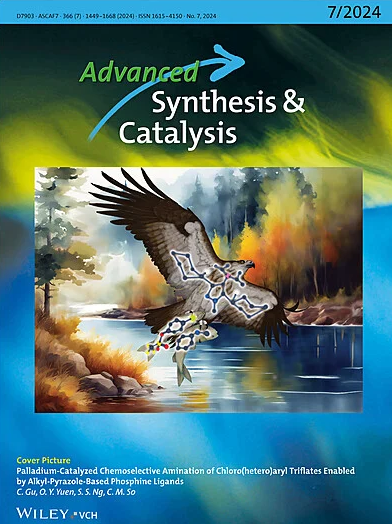Second-Generation One-pot Enantioselective Heck-Matsuda Arylations of Unactivated Olefins Directly from Anilines and Nitroarenes
IF 4.4
2区 化学
Q2 CHEMISTRY, APPLIED
引用次数: 0
Abstract
A highly improved second generation of the one-pot enantioselective Heck-Matsuda reaction directly from anilines and nitroarenes is reported. This practical arylation method, featuring 56 examples, relies on the in situ diazotization of anilines and 3-aminothiophenes, or from the in situ reduction-diazotization of nitrobenzene derivatives. The in situ diazotization of the aniline, directly or from the in-situ reduction of the nitroarene, synchronizes smoothly with the enantioselective Heck-Matsuda reaction under mildly acidic conditions, bypassing the synthesis and handling of some unstable and/or difficult-to-prepare arenediazonium salts. The protocol was applied to the desymmetrization of unactivated olefins leading to the synthesis of functionalized spirocyclopentenyl hydantoins, aryl cyclopentenes, and β-aryl-γ-lactones, in high yields (up to 99%) and er (up to 99:1). The efficiency of the method is showcased by the formal total synthesis of the bioactive compound VPC01091, a potential drug candidate for multiple sclerosis treatment at the gram scale in excellent yield (94%), in 97:3 er and 20>1 dr.求助全文
约1分钟内获得全文
求助全文
来源期刊

Advanced Synthesis & Catalysis
化学-应用化学
CiteScore
9.40
自引率
7.40%
发文量
447
审稿时长
1.8 months
期刊介绍:
Advanced Synthesis & Catalysis (ASC) is the leading primary journal in organic, organometallic, and applied chemistry.
The high impact of ASC can be attributed to the unique focus of the journal, which publishes exciting new results from academic and industrial labs on efficient, practical, and environmentally friendly organic synthesis. While homogeneous, heterogeneous, organic, and enzyme catalysis are key technologies to achieve green synthesis, significant contributions to the same goal by synthesis design, reaction techniques, flow chemistry, and continuous processing, multiphase catalysis, green solvents, catalyst immobilization, and recycling, separation science, and process development are also featured in ASC. The Aims and Scope can be found in the Notice to Authors or on the first page of the table of contents in every issue.
 求助内容:
求助内容: 应助结果提醒方式:
应助结果提醒方式:


